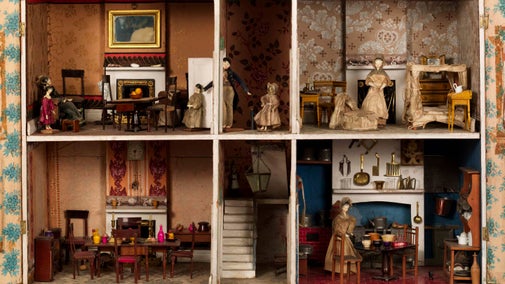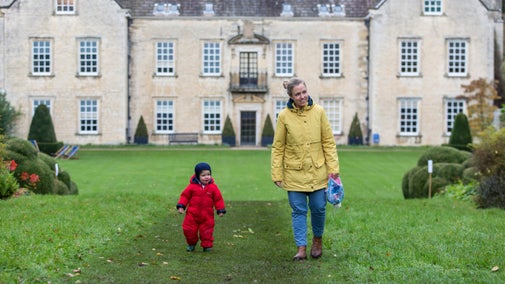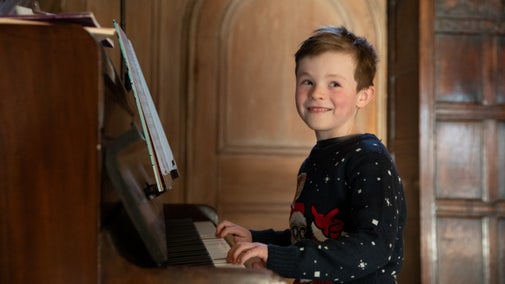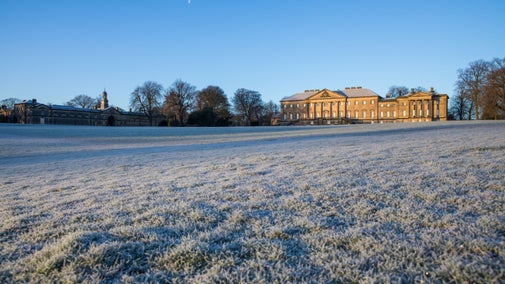
Discover more at Nunnington Hall
Find out when Nunnington Hall is open, how to get here, the things to see and do and more.

A dwelling is recorded at Nunnington from 1249, but the existing house has grown out of a Tudor Hall. Over the past 450 years the house and estate have been altered to suit a succession of owners and tenants. The house you see today is a fascinating combination of renovation and re-purpose, creating an atmospheric and comfortable home.
Historic buildings are full of secrets. Quirky corners, hidden details, or doors that seem to lead nowhere. Sometimes, their original meaning is lost. Other times, they give a tantalising glimpse into what life was like for past residents.
This year, from the moment visitors enter the hall we are inviting them to delve into the architectural oddities of this 500-year-old house, and uncover the stories of those who lived here.
In 1920 Nunnington Hall, in a poor state and uninhabited for a number of years, was inherited by Margaret Fife from her uncle, Henry. Margaret had always adored Nunnington and as a girl used to stay in a farmhouse in the village and became very attached to the dilapidated house, ‘the big house’.
She soon made the decision to sell her main property, Newby Wiske Hall, in order to fund the renovations for Nunnington.
Margaret was a strong, principled character, amusing with an infectious laugh. She met Ronald Fife at a country house shooting party in Cheshire in 1912, during which he proposed. Ronald was a man of action, a professional soldier, serving in colonies overseas including South Africa and India. When not away for duty he was still a keen sportsman and big-game hunter. By 1917 the couple had adopted two young girls, Susan and Rosalind.
During Lord Preston’s remodelling, in the late 17th century, this room became an entrance hall. It was fitted out accordingly with impressive door-cases with open topped pediments, a screen of three arches and a stone floor laid in a sophisticated pattern of squares and hexagons.

At the heart of the house, the Stone Hall was a Great Hall in the 16th century, a kitchen in the 17th century and by 1921 an Entrance Hall in which parties were held and table tennis was played. Walter Brierley, the architect engaged by the Fife's to renovate the hall, reinstated the Tudor origins and the walls were adorned with Colonel Fife's game trophies.
In the 17th century this room was Lord Preston’s bedchamber, with adjacent closet. In imitation of the Court of Versailles he would receive visitors, take meals and sleep here. By the 20th century the space was used by Colonel Fife as his Smoking Room and was painted a ‘Georgian Green’ colour with mezzotints adorning the walls.
Lord Preston’s great chamber became the Fife’s Drawing Room, where the French windows open to a balcony overlooking the garden. Mrs Fife and her daughters spent their evenings in the Drawing Room, playing and listening to music.
Housed at Nunnington since 1981, the Carlisle Collection is now an intrinsic part of the house and collection. Gifted to the National Trust in 1970 and is regarded by many as one of the finest collections of miniatures. The collection is noted for the high-quality craftsmanship and attention to detail, as well as its unusual scale.
The collection was the creation of Mrs Carlisle, fondly known as Kitty, began as a few pieces of miniature Indian silver displayed in an alcove of her London home. She began collecting antique miniatures in 1921 and over the next 40 years, the collection grew to form a magnificent collection of period rooms.

As well as miniature pieces of silver, glass, china, pictures and treen (turned wood), Kitty also collected furniture makers’ scale samples. She commissioned a number of highly skilled craftsmen to construct rooms and provide further furniture and fittings. The same attention to detail was applied to every item such as entire works of Shakespeare in miniature print, instruments in the music room that could be played and artwork on the walls of the picture gallery were made by framing decorative needle wrappers.
It was Mrs Carlisle’s wish for the collection to be cared for by the National Trust, and to bring as much joy to others as it did to her. The collection is permanently on display at Nunnington Hall on the second floor.
With a changing programme of exhibitions, expect diverse displays of photogrpahy, painting, illustrations and sculpture. Alongside this, the communty gallery offers a place for newer artists and community groups to display their work locally.

Find out when Nunnington Hall is open, how to get here, the things to see and do and more.
Discover how the conservation team at Nunnington care for the numerous items in our collections, and find out how we deal with certain unwelcome insect visitors to the Hall

Read about the new research into the 19th-century owners of Nunnington Hall which helped us to trace the source of some of their wealth accumulated as derived from the slave trade

Explore the items we care for at Nunnington Hall on the National Trust Collections website.

The garden at Nunnington Hall is the perfect place to enjoy some peace and quiet. Peaceful hidden spots, colourful peacocks and colourful flowers offer a great day out.

There's plenty for all of the family to do on a visit to Nunnington Hall. From art exhibitions to games, crafts and more, including our Lion's Den play area.

Find out all you need to know about the roles we offer at Nunnington Hall, from story sharing to helping in the garden, and hear some thoughts from some of the volunteers themselves.

Discover Yorkshire's history with visits to the grand halls of Nostell and Beningbrough, and the family homes of East Riddlesden and Ormesby Hall, while the ruins of Fountains Abbey will give you a different perspective.
